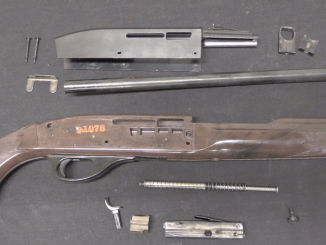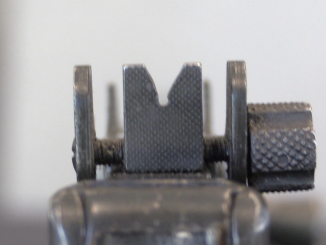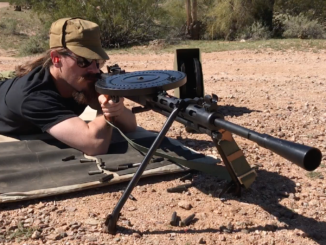The M1819 Hall rifle was the first breechloader adopted on a wide scale by a military force (the British Ferguson predated it, but was only made in small numbers). The Hall stayed in production on and off for several decades, being made in many configurations. This particular one is an 1836 pattern smoothbore Hall carbine, with a retracting spike bayonet.
This is the last of the videos I had the chance to make at Rock Island, and they are all going to be up for sale at the Premier auction this coming weekend – along with a couple thousand other guns. I hope you enjoyed these videos, and hopefully I will have the opportunity to do this again at another future auction!




Later Hall carbines, notably those made by Simeon North, had a long side lever alongside the breechblock to release the latch. This was due to complaints from the troops that the toothlike underlever injured their shoulders when the rifle was carried in the upright shoulder arms position. (It looks well-designed to spear you right in the anterior deltoid or clavicalus.)
One handy attribute of the Hall was that by removing the cross-screw which secured the breechblock, the breechblock could be removed from the weapon. While this facilitated cleaning, it also allowed the breech (which included the entire firing mechanism) to be loaded with powder and ball and used as a crude but effective pistol. During the Mexican War, soldiers on furlough did this to provide themselves with protection in case they were waylaid by irate locals enroute to a cantina.
Halls used in the American Civil War came in two persuasions. Reconditioned Hall carbines were used by General John C. Fremont’s Army of the West in the early years of the war. Reworked by George Eastman’s company (of later “Kodak” fame), they were bored out to .58 rifled from .54 smoothbore so they could use standard Minie’ balls with the musketoon charge, and fitted with adjustable rear sights. (I’ve often though a pepperbox-style “bar hammer” would have been a useful modification, too.)
Meanwhile, Halls in Southern arsenals were being refurbished for use by the CSA. Some were virtually complete rebuilds, with the breechblock cut off just ahead of the hammer base, and the resulting “box lock” mechanism put in a new stock with the hammer striking a cap nipple on the rear of an entirely new muzzle-loading barrel, usually .58 rifled;
http://milpas.cc/rifles/ZFiles/Articles/History/Civil%20War%20American%20Armories/Southern%20Civil%20War%20Muskets/READ%20&%20WATSON%20MUZZLE-LOADING%20RIFLE/READ%20&%20WATSON%20MUZZLE-LOADING%20RIFLE.%202.jpg
More commonly, the Halls were converted to muzzle loaders by simply welding the breechblock solidly to the rear end of the barrel.
One last note. If you look closely at the breechblock latch system of the 1819 Hall, It works very much like the “lock mechanism” of a much older weapon. That being the string release or “nut” of a heavy military crossbow of the pre-gunpowder era. It’s just turned around “backward” from its orientation in the crossbow stock.
😉
cheers
eon
Is there any reason why they weren’t rifled?
When the Hall was introduced in 1819, the smoothbore musket was still the default military arm. It had ruled the battlefield for over three centuries, from Cerignola in 1503 to Waterloo in 1815. The whole point of the Hall breechloader was not really greater accuracy; it was massed volley fire with a higher rate of fire than the muzzle-loading musket.
It’s interesting to note that most of the early Hall breechloaders were smoothbores in .64 caliber. IIRC, this allowed them to use the standard ball of the .69 caliber smoothbore musket, which was deliberately made .03″ smaller in diameter than the musket bore to allow faster loading “down the spout”.
This of course did nothing for the accuracy in the muzzle-loader. But since the Hall loaded from the breech, the ball was basically swaged into the slightly smaller bore on firing, which meant it traveled straight down the bore instead of bouncing from side to side and up and down inside like a marble in a pipe.
As such, the smoothbore .64 Hall was probably more accurate than the .69 smoothbore musket, but that wasn’t really considered a critical factor in the tactics of the day. The Hall was apparently intended to make at least some pretense to accuracy, as shown by its fixed rear sight; the musket had only a front bead like a shotgun, and no rear sight at all.
By comparison, the first official issue U.S. Army issue rifle, the Model of 1814, was a .54 caliber muzzle-loader, half-stocked rather than full-stocked, with a half-octagon, half-round barrel. It was essentially a “militarized” Pennsylvania/Kentucky rifle, and a direct forerunner of the “plains rifle”.
In fact, M1814s were fairly common with frontiersmen during the fur trade era; the “true” plains rifle only came along in the last few years of the “long hunters'” reign. The pioneers, settlers, and guides who followed them West from about 1845 to the early 1870s were the main market for the St. Louis smiths who made “Hawken” type rifles.
They were especially favored by “sodbusters” toward the end of the period because they were cheap by then (average price about $10 brand new), lighter than an ex-military rifle-musket, and could use loose powder and ball instead of expensive and possibly scarce metallic cartridge “fixed” ammunition like the “newfangled” breechloaders and repeating rifles. And it would drop just about any animal west of the Mississippi with one shot if the shooter did his part.
For the last two reasons, I maintain that anyone looking for a “survival rifle” for a long-term TEOTWAWKI situation today could do a lot worse than just getting a typical modern-day flintlock “Hawken” reproduction in about .50 caliber. If all else fails, you can always make your own ammo from scratch for one of those; some of my ancestors on the Native American side did it all the time.
cheers
eon
I was thinking perhaps the breech loading idea was to do with firing it through rifling more efficiently and indeed more quickly as a consequence i.e. less resistance, for ramming the projectile in at the muzzle and a tighter fit for it up from the breech type thing. But I can see what you mean, simply about speed, volleys etc.
Using the action as a pistol was quite novel…
Might be an ok layout for modern inline muzzle loaders, with a few modifications.
Pop a Treeby chain gun single chamber in the Hall rifles pop up chamber, and have a barrel like the treeby to seal the action and indeed lock it.
A Treeby chamber, inside the Hall chamber, with a bolt handle protruding for a turn bolt probably better.
Or the Norwegian 1842 model also used by Denmark, with a Hall-type block operated by a side “crank” that cammed it backward before raising it on its pivot, and then cammed it forward to meet up with the barrel. It also had an underhammer like a boot pistol, in front of the trigger guard with an external “bow” spring powering it.
That arrangement is the one thing about it I don’t much like. I think a late Pennsylvania-type “mule ear” side hammer would be a better choice overall. Lever on the right, mule-ear hammer just below it.
cheers
eon
The main problem with the Hall design was the lack of a proper gas seal at the breech. They tended to spray burned powder upwards in the shooter’s face, and the junction of breech and barrel was a weak spot that would occasionally blow open on its own, at times with painful results. Most accounts show that they weren’t very popular with the troops who were issued them, and the popularity of the M 1842 and subsequent muzzleloaders tends to illustrate this. Collector’s Armory has a number of Confederate Hall conversions from the Michel collection in their inventory. Most are crudely converted Model 1819 flintlocks that have survived in very rough condition, and were found in Texas. Some retained their breech mechanisms while others were converted to muzzleloaders by welding the breech-block to the barrel. They retain their flintlock hammers, modified to percussion using several methods, with a nipple and touchhole added. One example appears to have suffered a catastrophic breech failure with resulting damage to the right side of the stock. They are all well used, illustrating the desperation for small arms that the Confederacy suffered from throughout the war. Considering the number of surviving examples, there were likely a pretty good number of conversions done, with most turned into muzzleloaders. All in all, an interesting group of relics with a lot of history behind them. If only they could talk.
“The main problem with the Hall design was the lack of a proper gas seal at the breech.”
This was major problem of all breech-loader rifles before metallic cartridge was introduced. For example later Prussian Dreyse gun uses bolt action and paper cartridge and also have problem with escaping gases.
The North-made Halls had a slight bevel to the front of the breechblock (with the forward “edge” on top) and the trunnion was made as a slight eccentric to cam the block forward just a bit as it closed. The idea was to get as tight a seal as possible with a metal-to-metal contact.
Inspection of a North hall today generally shows less evidence of leakage and gas-cutting of the joint on top than earlier models. It also most likely shows greater powder residue down in the front of the breechblock recess in the stock.
The Hall really needed a ductile-metal seal “ring” like the Sharps percussion rifle and carbine. I don’t recall if the last Hall models in the 1840s were so modified or not.
cheers
eon
A friend just restored a hall rifle with a new stock, the metal was ok, the original stock what was left of it was dry rotted, but I saw something that interested me. When I looked at the photo I took of the markings, I noticed that the 1831 date was upside down. I have not seen another Hall like that, of course I have no seen many Halls. Any significance??? Had J H HALL H. FERRY US then 1831 upside down.
Very interesting info what roll if any did the Hall breech loader play in the War of 1812?
Doesn’t say much about this in the history books, I know there was some of his rifles used during the later time (New Orleans battle). I’m a descendant of the Rifle maker J.H.Hall.
The Hall had not entered production in time to be used in the War of 1812.